Estimating Climate-Sensitive Wildfire Risk and Tree Mortality Models for Use in Broad-Scale U.S. Forest Carbon Projections
Abstract
1. Introduction
2. Materials and Methods
2.1. Data
2.2. Variable Descriptions and Model Specification
2.3. Model Fitting and Validation
2.4. Combustion Emissions Due to the Wildfires in the United States
3. Results
3.1. Annual Probabilities of Wildfire Occurrence from Fire Risk Equation
3.2. Annual Probabilities of Biomass Loss Due to Tree Mortality from TreeBio-Loss Equation
3.3. Carbon Dioxide Emissions Due to the Wildfires in the United States
4. Discussion
5. Conclusions
Author Contributions
Funding
Data Availability Statement
Acknowledgments
Conflicts of Interest
References
- Forest History Society, U.S. Forest Service Fire Suppression—Forest History Society. Available online: https://foresthistory.org/research-explore/us-forest-service-history/policy-and-law/fire-u-s-forest-service/u-s-forest-service-fire-suppression/ (accessed on 4 December 2018).
- Busenberg, G. Wildfire Management in the United States: The Evolution of a Policy Failure. Rev. Policy Res. 2004, 21, 145–156. [Google Scholar] [CrossRef]
- MTBS Fire Bundles: National Datasets. Available online: https://www.mtbs.gov/direct-download (accessed on 13 November 2018).
- Dennison, P.E.; Brewer, S.C.; Arnold, J.D.; Moritz, M.A. Large Wildfire Trends in the Western United States, 1984–2011. Geophys. Res. Lett. 2014, 41, 3307–3314. [Google Scholar] [CrossRef]
- Balch, J.K.; Bradley, B.A.; Abatzoglou, J.T.; Nagy, R.C.; Fusco, E.J.; Mahood, A.L. Human-Started Wildfires Expand the Fire Niche across the United States. Proc. Natl. Acad. Sci. USA 2017, 114, 2946–2951. [Google Scholar] [CrossRef] [PubMed]
- Donato, D.C.; Fontaine, J.B.; Campbell, J.L.; Robinson, W.D.; Kauffman, J.B.; Law, B.E. Post-Wildfire Logging Hinders Regeneration and Increases Fire Risk. Science 2006, 311, 352. Available online: https://www.science.org/doi/10.1126/science.1122855 (accessed on 13 November 2022). [CrossRef]
- Barbero, R.; Abatzoglou, J.T.; Larkin, N.K.; Kolden, C.A.; Stocks, B. Climate Change Presents Increased Potential for Very Large Fires in the Contiguous United States. Int. J. Ofwildl. Fire 2015, 24, 892–899. [Google Scholar] [CrossRef]
- Westerling, A.L.; Hidalgo, H.G.; Cayan, D.R.; Swetnam, T.W. Warming and Earlier Spring Increase Western U.S. Forest Wildfire Activity. Science 2006, 313, 940–943. [Google Scholar] [CrossRef] [PubMed]
- Westerling, A.L.; Bryant, B.P. Climate Change and Wildfire in California. Clim. Chang. 2008, 87, 231–249. [Google Scholar] [CrossRef]
- Wilson, B.T.; Woodall, C.W.; Griffith, D.M. Imputing Forest Carbon Stock Estimates from Inventory Plots to a Nationally Continuous Coverage. Carbon Balance Manag. 2013, 8, 1. [Google Scholar] [CrossRef]
- Coulston, J.W.; Wear, D.N.; Vose, J.M. Complex Forest Dynamics Indicate Potential for Slowing Carbon Accumulation in the Southeastern United States. Sci. Rep. 2015, 5, 8002. [Google Scholar] [CrossRef]
- Birdsey, R.; Pregitzer, K.; Lucier, A. Forest Carbon Management in the United States. J. Environ. Qual. 2006, 35, 1461–1469. [Google Scholar] [CrossRef]
- U.S. Environmental Protection Agency. Inventory of U.S. Greenhouse Gas Emissions and Sinks: 1990–2017; U.S. Environmental Protection Agency: Washington, DC, USA, 2019; Volume EPA 430-P, Available online: https://www.epa.gov/sites/default/files/2019-04/documents/us-ghg-inventory-2019-main-text.pdf (accessed on 13 November 2022).
- White House. United States Mid-Century Strategy for Deep Decarbonization; White House: Washington, DC, USA, 2016; Available online: https://unfccc.int/files/focus/long-term_strategies/application/pdf/mid_century_strategy_report-final_red.pdf (accessed on 13 November 2022).
- U.S. Department of Agriculture Forest Service. Future of America ’ s Forests and Rangelands; Volume Gen. Tech.; U.S. Department of Agriculture Forest Service: Washington, DC, USA, 2010. Available online: https://www.fs.usda.gov/research/publications/gtr/gtr_wo87.pdf (accessed on 13 November 2022).
- Intergovernmental Panel on Climate Change (IPCC). 2006 IPCC Guidelines for National Greenhouse Gas Inventories; Eggleston, S., Buendia, L., Miwa, K., Ngara, T., Tanabe, K., Eds.; Institute for Global Environmental Strategies: Hayama, Japan, 2006; Volume 5, Available online: https://www.ipcc.ch/report/2006-ipcc-guidelines-for-national-greenhouse-gas-inventories/ (accessed on 13 November 2018).
- Macias Fauria, M.; Michaletz, S.T.; Johnson, E.A. Predicting Climate Change Effects on Wildfires Requires Linking Processes across Scales. Wiley Interdiscip. Rev. Clim. Chang. 2011, 2, 99–112. [Google Scholar] [CrossRef]
- Preisler, H.K.; Brillinger, D.R.; Burgan, R.E.; Benoit, J.W. Probability Based Models for Estimation of Wildfire Risk. Int. J. Wildl. Fire 2004, 13, 133–142. [Google Scholar] [CrossRef]
- Andrews, P.; Finney, M.; Fischetti, M. Predicting Wildfires. Sci. Am. 2007, 297, 46–55. Available online: https://www-jstor-org.proxy2.cl.msu.edu/stable/26069414?seq=8#metadata_info_tab_contents (accessed on 1 November 2022). [CrossRef] [PubMed]
- Finney, M.A.; McHugh, C.W.; Grenfell, I.C.; Riley, K.L.; Short, K.C. A Simulation of Probabilistic Wildfire Risk Components for the Continental United States. Stoch. Environ. Res. Risk Assess. 2011, 25, 973–1000. [Google Scholar] [CrossRef]
- Kerr, G.H.; DeGaetano, A.T.; Stoof, C.R.; Ward, D. Climate Change Effects on Wildland Fire Risk in the Northeastern and Great Lakes States Predicted by a Downscaled Multi-Model Ensemble. Theor. Appl. Climatol. 2018, 131, 625–639. [Google Scholar] [CrossRef]
- Stenzel, J.E.; Lutz, J.A.; Bartowitz, K.J.; Hartman, M.D.; Kolden, C.A.; Smith, A.M.S.; Law, B.E.; Swanson, M.E.; Larson, A.J.; Parton, W.J.; et al. Fixing a Snag in Carbon Emissions Estimates from Wildfires. Glob. Chang. Biol. 2019, 25, 3985–3994. [Google Scholar] [CrossRef]
- Gallego Arrubla, J.A.; Ntaimo, L.; Stripling, C. Wildfire Initial Response Planning Using Probabilistically Constrained Stochastic Integer Programming. Int. J. Wildl. Fire 2014, 23, 825–838. [Google Scholar] [CrossRef]
- Thompson, M.P.; Calkin, D.E.; Finney, M.A.; Ager, A.A.; Gilbertson-Day, J.W. Integrated National-Scale Assessment of Wildfire Risk to Human and Ecological Values. Stoch. Environ. Res. Risk Assess. 2011, 25, 761–780. [Google Scholar] [CrossRef]
- González-Olabarria, J.-R.; Pukkala, T. Integrating Fire Risk Considerations in Landscape-Level Forest Planning. For. Ecol. Manag. 2011, 261, 278–287. [Google Scholar] [CrossRef]
- Siegel, K.J.; Larsen, L.; Stephens, C.; Stewart, W.; Butsic, V. Quantifying Drivers of Change in Social-Ecological Systems: Land Management Impacts Wildfire Probability in Forests of the Western US. Reg. Environ. Chang. 2022, 22, 98. [Google Scholar] [CrossRef]
- Cruz, M.G.; Alexander, M.E. Modelling the Rate of Fire Spread and Uncertainty Associated with the Onset and Propagation of Crown Fires in Conifer Forest Stands. Int. J. Wildland Fire 2017, 26, 413–426. [Google Scholar] [CrossRef]
- Cruz, M.G.; Alexander, M.E.; Wakimoto, R.H.; Viegas, D.X. Predicting Crown Fire Behavior to Support Forest Fire Management Decision-Making. In IForest Fire Research & Wildland Fire Safety, Proceedings of the IV International Conference on Forest Fire Research/2002 Wildland Fire Safety Summit, Luso-Coimbra, Portugal, 18–23 November 2002; Viegas, D.X., Ed.; Millpress Science Publications: Rotterdam, The Netherlands, 2002; p. 1.11. Available online: https://www.frames.gov/documents/catalog/cruz_et_al_2002.pdf (accessed on 13 November 2022).
- Qu, J.; Cui, X. Automatic Machine Learning Framework for Forest Fire Forecasting. J. Phys. Conf. Ser. 2020, 1651, 012116. [Google Scholar] [CrossRef]
- Seydi, S.T.; Saeidi, V.; Kalantar, B.; Ueda, N.; Halin, A.A. Fire-Net: A Deep Learning Framework for Active Forest Fire Detection. J. Sens. 2022, 2022, 8044390. [Google Scholar] [CrossRef]
- FIA FIA DataMart. Available online: https://apps.fs.usda.gov/fia/datamart/datamart.html (accessed on 13 November 2021).
- Mcroberts, R.E.; Bechtold, W.A.; Patterson, P.L.; Scott, C.T.; Reams, G.A. The Enhanced Forest Inventory and Analysis Program of the USDA Forest Service: Historical Perspective and Announcement of Statistical Documentation. J. For. 2005, 103, 304–308. [Google Scholar] [CrossRef]
- Bechtold, W.A.; Patterson, P.L. The Enhanced Forest Inventory and Analysis Program—National Sampling Design and Estimation Procedures; USDA Forest Service, Southern Research Station: Asheville, NC, USA, 2005. [Google Scholar] [CrossRef]
- Cleland, D.T.; Freeouf, J.A.; Keys, J.E.; Nowacki, G.J.; Carpenter, C.A.; McNab, W.H. Ecological Subregions: Sections and Subsections for the Conterminous United States; Gen. Tech. Rep. WO-76D Map on CD-ROM (A.M. Sloan, cartographer); presentation scale 1:3,500,000; colored; Department of Agriculture Forest Service: Washington, DC, USA, 2007. Available online: https://www.fs.usda.gov/research/treesearch/48672 (accessed on 13 November 2022).
- PRISM Climate Data: 30-Year Normals. Available online: http://prism.oregonstate.edu/normals/ (accessed on 13 November 2016).
- Daly, C.; Halbleib, M.; Smith, J.I.; Gibson, W.P.; Doggett, M.K.; Taylor, G.H.; Curtis, J.; Pasteris, P.P. Physiographically Sensitive Mapping of Climatological Temperature and Precipitation across the Conterminous United States. Int. J. Climatol. 2008, 28, 2031–2064. [Google Scholar] [CrossRef]
- Dorrepaal, E.; Aerts, R.; Cornelissen, J.H.; Callaghan, T.V.; Van Logtestijn, R.S. Summer Warming and Increased Winter Snow Cover Affect Sphagnum Fuscum Growth, Structure and Production in a Sub-Arctic Bog. Glob. Chang. Biol. 2004, 10, 93–104. [Google Scholar] [CrossRef]
- Godsey, S.E.; Kirchner, J.W.; Tague, C.L. Effects of Changes in Winter Snowpacks on Summer Low Flows: Case Studies in the Sierra Nevada, California, USA. Hydrol. Process. 2014, 28, 5048–5064. [Google Scholar] [CrossRef]
- Narongrit, C.; Chankao, K. Development and Validation of Rice Evapotranspiration Model Based on Terra/MODIS Remotely Sensed Data. J. Food Agric. Environ. 2009, 7, 684–689. Available online: https://www.wflpublisher.com/Abstract/2742 (accessed on 13 November 2022).
- Heij, C.; De Boer, P.; Franses, P.H.; Kloek, T.; Van Dijk, H.K. Econometric Methods with Applications in Business and Economics, 1st ed.; Oxford University Press: Oxford, UK, 2004. [Google Scholar]
- Auffhammer, M.; Hsiang, S.M.; Schlenker, W.; Sobel, A. Using Weather Data and Climate Model Output in Economic Analyses of Climate Change. Rev. Environ. Econ. Policy 2013, 7, 181–198. [Google Scholar] [CrossRef]
- Slocum, M.G.; Beckage, B.; Platt, W.J.; Orzell, S.L.; Taylor, W. Effect of Climate on Wildfire Size: A Cross-Scale Analysis. Ecosystems 2010, 13, 828–840. [Google Scholar] [CrossRef]
- Taylor, M.H.; Rollins, K.; Kobayashi, M.; Tausch, R.J. The Economics of Fuel Management: Wildfire, Invasive Plants, and the Dynamics of Sagebrush Rangelands in the Western United States. J. Environ. Manag. 2013, 126, 157–173. [Google Scholar] [CrossRef]
- Steel, Z.L.; Safford, H.D.; Viers, J.H. The Fire Frequency-Severity Relationship and the Legacy of Fire Suppression in California Forests. Ecosphere 2015, 6, 1–23. [Google Scholar] [CrossRef]
- Westerling, A.L. Increasing Western US Forest Wildfire Activity: Sensitivity to Changes in the Timing of Spring. Philos. Trans. R. Soc. B Biol. Sci. 2016, 371, 20150178. [Google Scholar] [CrossRef]
- Drever, C.R.; Drever, M.C.; Messier, C.; Bergeron, Y.; Flannigan, M. Fire and the Relative Roles of Weather, Climate and Landscape Characteristics in the Great Lakes-St. Lawrence Forest of Canada. J. Veg. Sci. 2008, 19, 57–66. [Google Scholar] [CrossRef]
- Starrs, C.F.; Butsic, V.; Stephens, C.; Stewart, W. The Impact of Land Ownership, Firefighting, and Reserve Status on Fire Probability in California. Environ. Res. Lett. 2018, 13, 034025. [Google Scholar] [CrossRef]
- Levine, J.I.; Collins, B.M.; Steel, Z.L.; de Valpine, P.; Stephens, S.L. Higher Incidence of High-Severity Fire in and near Industrially Managed Forests. Front. Ecol. Environ. 2022, 20, 397–404. [Google Scholar] [CrossRef]
- Lydersen, J.M.; Collins, B.M.; Brooks, M.L.; Matchett, J.R.; Shive, K.L.; Povak, N.A.; Kane, V.R.; Smith, D.F. Evidence of Fuels Management and Fire Weather Influencing Fire Severity in an Extreme Fire Event. Ecol. Appl. 2017, 27, 2013–2030. [Google Scholar] [CrossRef]
- Rummer, B.; Prestemon, J.; Forest, U.; May, D.; Miles, P.; Vissage, J.; Mcroberts, R.; Liknes, G.; Forest, U.; Shepperd, W.D.; et al. A Strategic Assessment of Forest Biomass and Fuel Reduction Treatments in Western States United States Department of Agriculture; United States Department of Agriculture: Washington, DC, USA, 2005. [Google Scholar] [CrossRef]
- Besnard, S.; Carvalhais, N.; Altaf Arain, M.; Black, A.; de Bruin, S.; Buchmann, N.; Cescatti, A.; Chen, J.; Clevers, J.G.P.W.; Desai, A.; et al. Quantifying the Effect of Forest Age in Annual Net Forest Carbon Balance. Environ. Res. Lett. 2018, 13, 124018. [Google Scholar] [CrossRef]
- Odion, D.C.; Hanson, C.T.; Arsenault, A.; Baker, W.L.; DellaSala, D.A.; Hutto, R.L.; Klenner, W.; Moritz, M.A.; Sherriff, R.L.; Veblen, T.T.; et al. Examining Historical and Current Mixed-Severity Fire Regimes in Ponderosa Pine and Mixed-Conifer Forests of Western North America. PLoS ONE 2014, 9, e87852. [Google Scholar] [CrossRef] [PubMed]
- Moran, P.A.P. Notes on Continuous Stochastic Phenomena. Biometrika 1950, 37, 17–23. [Google Scholar] [CrossRef]
- Littell, J.S.; McKenzie, D.; Peterson, D.L.; Westerling, A.L. Climate and Wildfire Area Burned in Western U.S. Ecoprovinces, 1916–2003. Ecol. Appl. 2009, 19, 1003–1021. [Google Scholar] [CrossRef]
- Kissling, W.D.; Carl, G. Spatial Autocorrelation and the Selection of Simultaneous Autoregressive Models. Glob. Ecol. Biogeogr. 2008, 17, 59–71. [Google Scholar] [CrossRef]
- Latta, G.S.; Baker, J.S.; Ohrel, S. A Land Use and Resource Allocation (LURA) Modeling System for Projecting Localized Forest CO2 Effects of Alternative Macroeconomic Futures. For. Policy Econ. 2018, 87, 35–48. [Google Scholar] [CrossRef] [PubMed]
- Esri, Using Web GIS to Build Consensus and Combat Wildland Fire Threats. 2016. Available online: https://www.esri.com/about/newsroom/arcuser/using-web-gis-to-build-consensus-and-combat-wildland-fire-threats/ (accessed on 1 November 2022).
- Loehman, R.A.; Reinhardt, E.; Riley, K.L. Wildland Fire Emissions, Carbon, and Climate: Seeing the Forest and the Trees—A Cross-Scale Assessment of Wildfire and Carbon Dynamics in Fire-Prone, Forested Ecosystems. For. Ecol. Manag. 2014, 317, 9–19. [Google Scholar] [CrossRef]
- Ohrel, S.; Beach, R.; Adams, D.; Alig, R.; Baker, J.; Latta, G.; McCarl, B.; Murray, B.; Rose, S.; White, E. Model Documentation for the Forest and Agricultural Sector Optimization Model with Greenhouse Gases (FASOMGHG). Available online: http://agecon2.tamu.edu/people/faculty/mccarl-bruce/FASOM.html (accessed on 13 November 2018).
- Baker, J.S.; Latta, G.; Forsell, N.; Sohngen, B. State of the Art Methods to Project Forest Carbon Stocks. J. For. Econ. 2019, 34, 1–5. [Google Scholar] [CrossRef]
- IPCC. Climate Change 2014: Mitigation of Climate Change. In Contribution of Working Group III to the Fifth Assessment Report of the Intergovernmental Panel on Climate Change; Edenhofer, O., Pichs-Madruga, R., Sokona, Y., Farahani, E., Kadner, S., Seyboth, K., Adler, A., Baum, I., Brunner, S., Eickemeier, P., Eds.; Cambridge University Press: Cambridge, UK, 2014; ISBN 1107058163. [Google Scholar]
- Latta, G.S.; Baker, J.S.; Beach, R.H.; Rose, S.K.; McCarl, B.A. A Multi-Sector Intertemporal Optimization Approach to Assess the GHG Implications of U.S. Forest and Agricultural Biomass Electricity Expansion. J. For. Econ. 2013, 19, 361–383. [Google Scholar] [CrossRef]
- Dieleman, C.M.; Rogers, B.M.; Potter, S.; Veraverbeke, S.; Johnstone, J.F.; Laflamme, J.; Solvik, K.; Walker, X.J.; Mack, M.C.; Turetsky, M.R. Wildfire Combustion and Carbon Stocks in the Southern Canadian Boreal Forest: Implications for a Warming World. Glob. Chang. Biol. 2020, 26, 6062–6079. [Google Scholar] [CrossRef]
- Rogers, B.M.; Neilson, R.P.; Drapek, R.; Lenihan, J.M.; Wells, J.R.; Bachelet, D.; Law, B.E. Impacts of Climate Change on Fire Regimes and Carbon Stocks of the U.S. Pacific Northwest. J. Geophys. Res. Biogeosci. 2011, 116, 1–13. [Google Scholar] [CrossRef]
- Pasila, A. Changes, Challenges and Opportunities in the Wood Energy Supply Chain. Agron. Res. 2013, 11, 529–532. Available online: https://agronomy.emu.ee/wp-content/uploads/2013/10/p11230.pdf#abstract-3077 (accessed on 13 November 2022).
- Campbell, J.L.; Sessions, J.; Smith, D.; Trippe, K. Potential Carbon Storage in Biochar Made from Logging Residue: Basic Principles and Southern Oregon Case Studies. PLoS ONE 2018, 13, e0203475. [Google Scholar] [CrossRef] [PubMed]
- Riley, K.L.; Loehman, R.A. Mid-21stcentury Climate Changes Increase Predicted Fire Occurrence and Fire Season Length, Northern Rocky Mountains, United States. Ecosphere 2016, 7, e01543. [Google Scholar] [CrossRef]
- Westerling, A.L.; Gershunov, A.; Brown, T.J.; Cayan, D.R.; Dettinger, M.D. Climate and Wildfire in the Western United States. Bull. Am. Meteorol. Soc. 2003, 84, 595–604. [Google Scholar] [CrossRef]
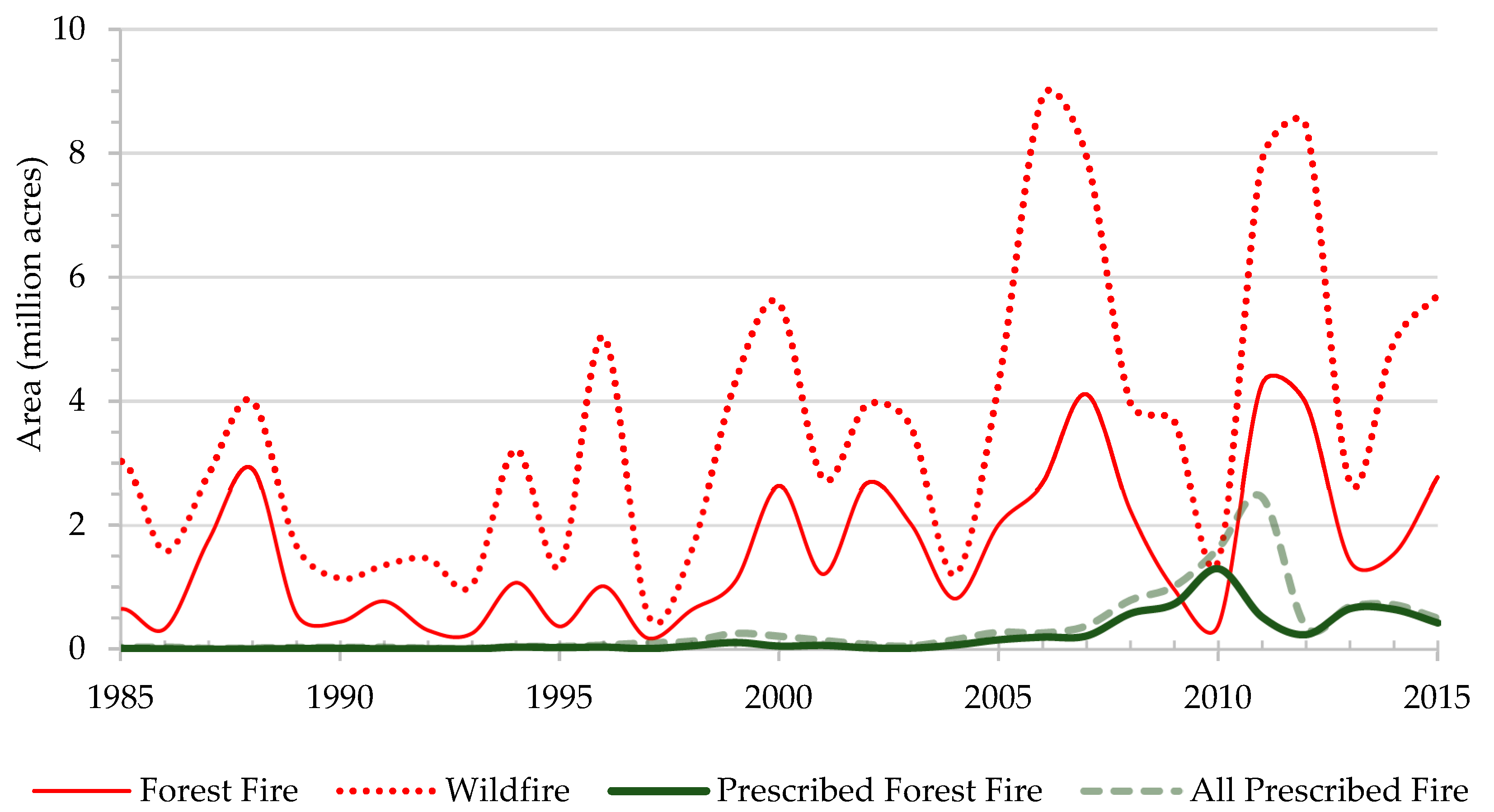
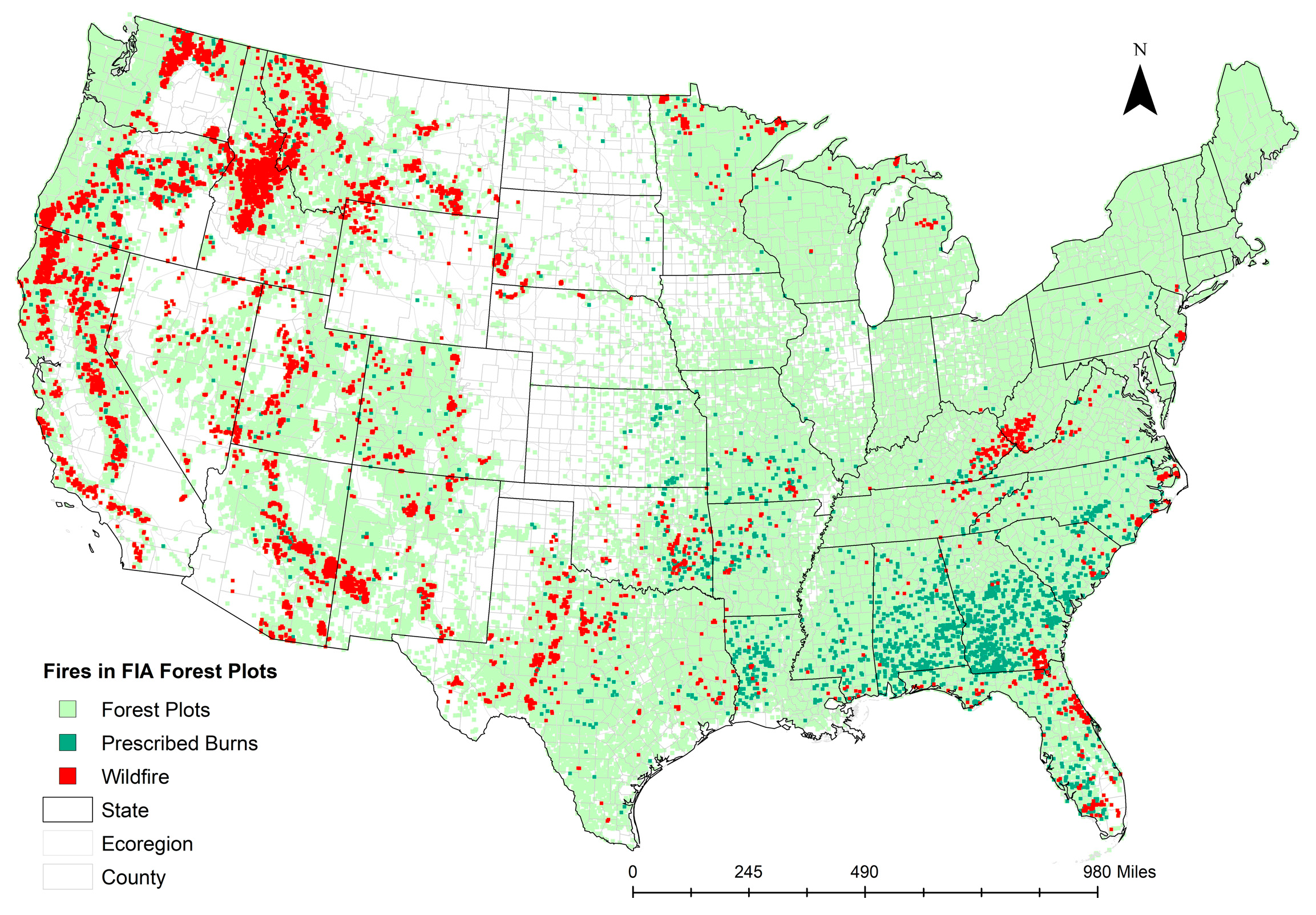
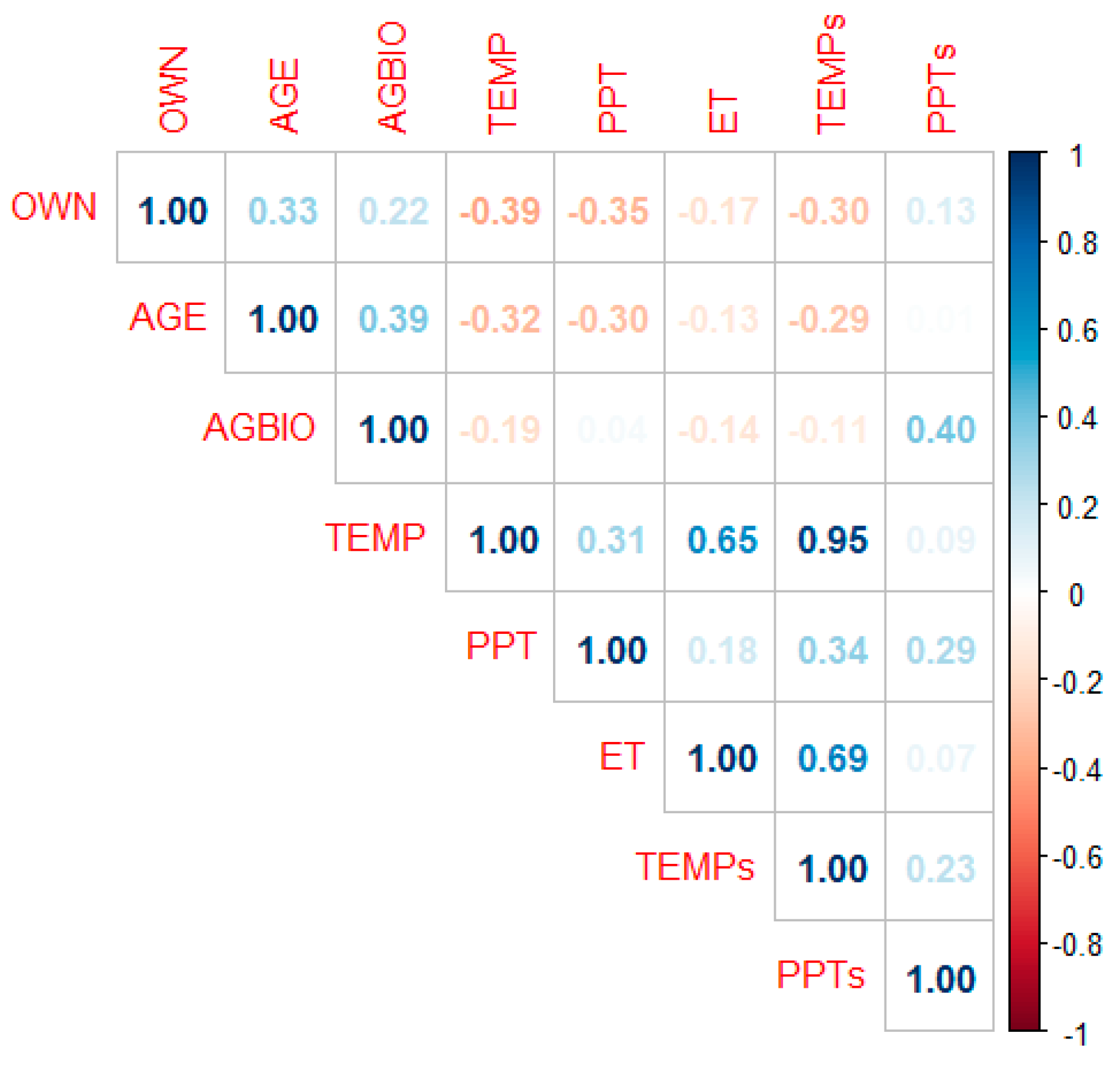
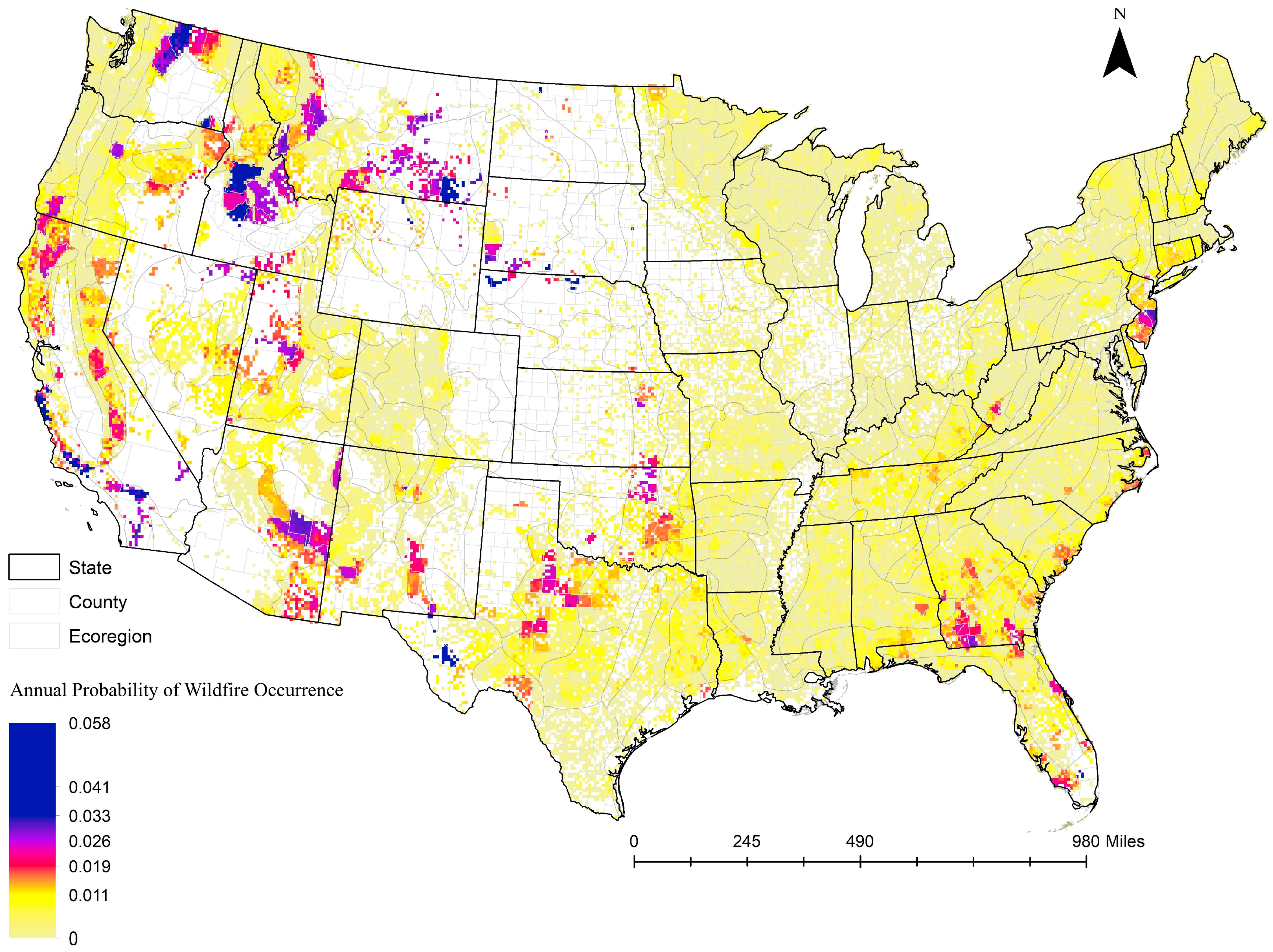
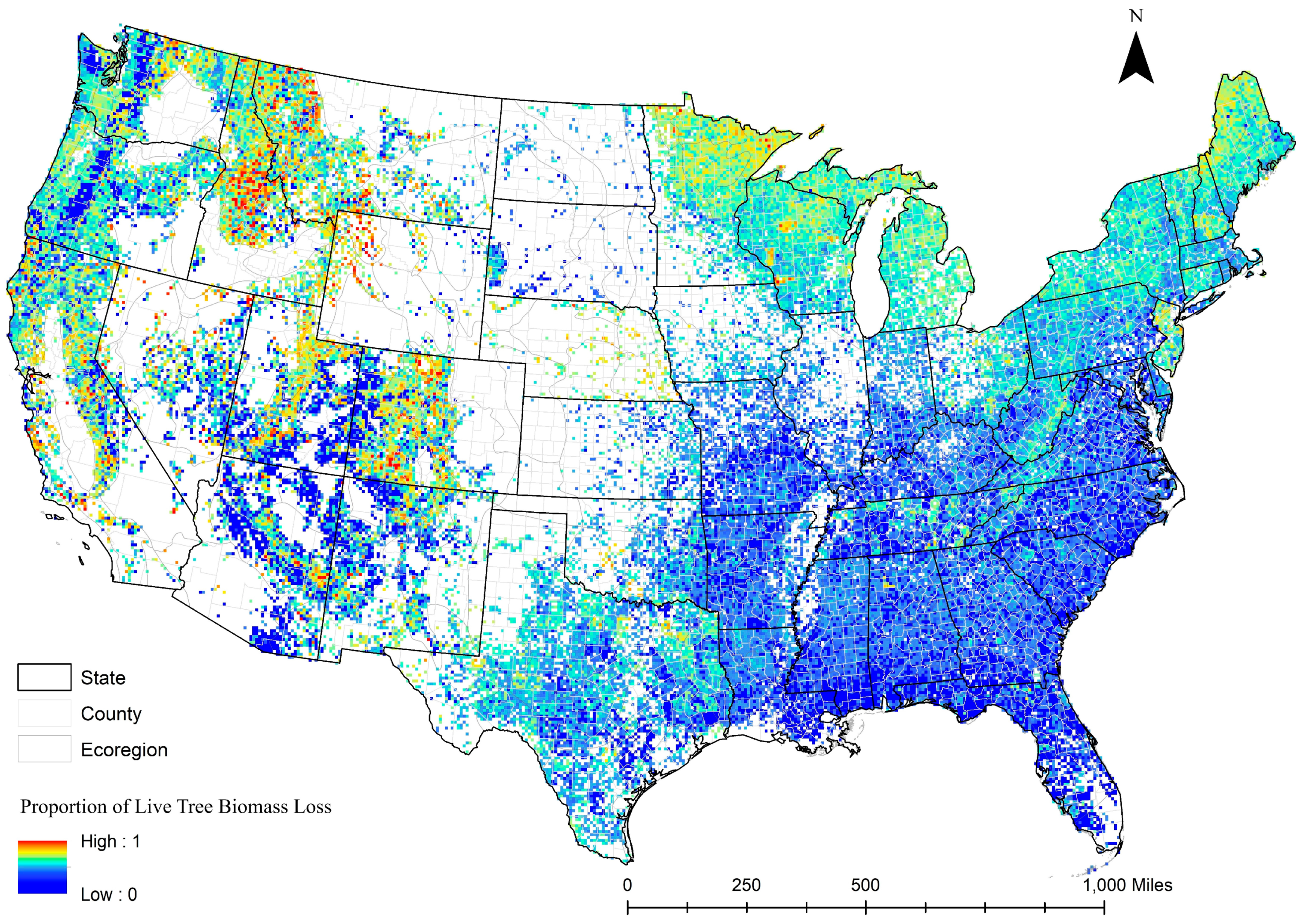
| Variable | Description | N 2 | Mean | SD 3 | Median | Min | Max |
|---|---|---|---|---|---|---|---|
| FIRE 1 | Number of plots experiencing wildfire and unknown fires between 2000 and 2015. 1 if a fire was reported, 0 otherwise. | 150,350 | 0.07 | 0.25 | 0 | 0 | 1.00 |
| TREELOSS 4 | Proportion of aboveground live biomass in dead or missing trees in remeasurements after a wildfire event in an FIA plot between 2000 and 2015. | 4510 | 0.23 | 0.36 | 0.02 | 0 | 1.00 |
| AGBIO | Total aboveground live tree biomass in a plot (1000 metric tons per hectare). | 150,350 | 26.82 | 30.80 | 17.98 | 0 | 1049 |
| AGE | Age of the forest stand of the plot. | 150,350 | 65.24 | 55.40 | 57 | 0 | 1028 |
| OWN | Ownership of the plot, 1 if federally owned, 0 otherwise. | 150,350 | 0.25 | 0.44 | 0.00 | 0.00 | 1.00 |
| Fire Season or Summer (July, August, September, and October) | |||||||
| PPT | Average monthly precipitation in millimeters (mm) for the plot between 1985 and 2015. | 150,350 | 82.00 | 33.13 | 90.99 | 2.59 | 246.60 |
| TEMP | Average monthly maximum temperature for the plot in degree Celsius between 1985 and 2015. | 150,350 | 25.09 | 4.52 | 24.95 | 10.48 | 41.95 |
| ET | Average monthly evapotranspiration for the plot in mm between 1985 and 2015. | 150,350 | 405 | 69 | 412 | 250 | 687 |
| Spring Season (February, March, and April) | |||||||
| PPTs | Average monthly precipitation in millimeters (mm) for the plot between 1985 and 2015. | 150,350 | 87.28 | 50.41 | 85.21 | 5.24 | 594.57 |
| TEMPs | Average monthly maximum temperature for the plot in degree Celsius between 1985 and 2015. | 150,350 | 12.08 | 6.56 | 11.62 | −2.00 | 27.98 |
| ETs | Average monthly evapotranspiration for the plot in mm between 1985 and 2015. | 150,350 | 220 | 72 | 217 | 95 | 492 |
| Scenarios | Estimate of Wildfire Probability (pi) | Estimate of Wildfire Probability (mi) | Rate of Conversion or Consumption | |
|---|---|---|---|---|
| Bole and Stump Biomass Combustion Rate (fb) | Tops, Branches, and Sapling Biomass Combustion Rate (fo) | |||
| AVG_low | is the average (2005–2015) annual probability of wildfire occurrence for a county. | is the average (2005–2015) annual probability of tree mortality for a county. | 5% | 50% |
| AVG_med | 30% | 80% | ||
| AVG_high | 46% | 92% | ||
| AVG_cats | 80% | 100% | ||
| ECP_low | is the annual probability of wildfire occurrence on cth ecoregion within a county from the fire risk model. | is the annual probability of tree mortality on ith plot from the TreeBio-Loss model. | 5% | 50% |
| ECP_med | 30% | 80% | ||
| ECP_high | 46% | 92% | ||
| ECP_cats | 80% | 100% | ||
| PLT_low | is the annual probability of wildfire occurrence on ith plot with the fire risk model. | is the annual probability of tree mortality on ith plot with the TreeBio-Loss model. | 5% | 50% |
| PLT_med | 30% | 80% | ||
| PLT_high | 46% | 92% | ||
| PLT_cats | 80% | 100% | ||
| Variables (n = 3854) | Coefficient | Standard Error | p-Value | |
|---|---|---|---|---|
| Intercept | −0.17030 | 0.07410 | 0.022 | |
| PPT | −0.00738 | 0.00070 | 0.000 | |
| TEMP | 0.07472 | 0.02325 | 0.001 | |
| ET | −0.26480 | 0.07533 | 0.000 | |
| PPTs | −0.00011 | 0.00013 | 0.401 | |
| TEMPs | −0.08526 | 0.01618 | 0.000 | |
| ETs | 4.74 × 10−7 | 4.07 × 10−7 | 0.244 | |
| PPT2 | 0.00001 | 2.25 × 10−6 | 0.000 | |
| TEMP2 | −0.00556 | 0.00069 | 0.000 | |
| ET2 | −0.05155 | 0.01604 | 0.001 | |
| PPTs2 | −0.00304 | 0.00046 | 0.000 | |
| TEMPs2 | 2.47 × 10−6 | 7.33 × 10−7 | 0.001 | |
| ETs2 | 2.80 × 10−12 | 9.47 × 10−13 | 0.003 | |
| PPT * TEMP | −0.00004 | 0.00005 | 0.413 | |
| PPT * ET | 0.00160 | 0.00031 | 0.000 | |
| PPT * PPTs | −0.00001 | 2.02 × 10−6 | 0.000 | |
| TEMP * TEMPs | 0.00644 | 0.00107 | 0.000 | |
| TEMP * ET | 0.02710 | 0.00363 | 0.000 | |
| ET * ETs | −2.65 × 10−7 | 8.39 × 10−8 | 0.002 | |
| OWN | 0.01358 | 0.00292 | 0.000 | |
| Spatial autocorrelation | ς | 1.33100 | 0.00934 | 0.000 |
| Root mean squared error (RMSE) * | 0.077 | |||
| Fit index (FI) ** | 0.56 |
| Variables (n = 4510) | Coefficient | Standard Error | p-Value | |
|---|---|---|---|---|
| Intercept | 2.26700 | 0.44450 | 0.000 | |
| PPT | −0.00513 | 0.00213 | 0.016 | |
| TEMP | 0.10640 | 0.07137 | 0.136 | |
| ET | −2.51700 | 0.60840 | 0.000 | |
| PPTs | 0.00038 | 0.00038 | 0.315 | |
| TEMPs | −0.12660 | 0.05568 | 0.023 | |
| ETs | 1.00300 | 0.62190 | 0.107 | |
| PPT2 | 0.00001 | 0.00000 | 0.003 | |
| TEMP2 | −0.00418 | 0.00214 | 0.050 | |
| ET2 | 0.54960 | 0.13870 | 0.000 | |
| PPTs2 | 3.85 × 10−6 | 1.13 × 10−6 | 0.001 | |
| TEMPs2 | −0.00295 | 0.00163 | 0.070 | |
| ETs2 | 0.36410 | 0.15080 | 0.015 | |
| PPT * TEMP | −0.00032 | 0.00009 | 0.001 | |
| PPT * ET | 0.00267 | 0.00077 | 0.001 | |
| PPT * PPTs | −0.00002 | 4.00 × 10−6 | 0.000 | |
| TEMP * TEMPs | 0.00778 | 0.00347 | 0.025 | |
| TEMP * ET | 0.00128 | 0.00806 | 0.874 | |
| ET * ETs | −0.76150 | 0.26940 | 0.005 | |
| OWN | 0.05385 | 0.00843 | 0.000 | |
| AGE | −0.00245 | 0.00007 | 0.000 | |
| AGBIO | 3.49 × 10−7 | 9.74 × 10−8 | 0.000 | |
| Spatial autocorrelation | 0.42470 | 0.02871 | 0.000 | |
| Root mean squared error (RMSE) * | 0.237 | |||
| Fit index (FI) ** | 0.57 |
| Scenarios | Scenario Description | Wildfire Burn Area (1000 ha) A | Total AG Biomass in the Burn Area (MMt) | Live Tree Biomass Loss with Mortality (MMt) B | CO2 Emissions (MMt/year) C |
|---|---|---|---|---|---|
| AVG_low | = 0.5 | 775.18 | 55.43 | 2.04 | 3.73 |
| AVG_med | = 0.8 | 775.18 | 55.43 | 5.37 | 9.84 |
| AVG_high | = 0.92 | 775.18 | 55.43 | 7.28 | 13.35 |
| AVG_cats | = 1 | 775.18 | 55.43 | 10.79 | 19.79 |
| ECP_low | = 0.5 | 964.61 | 77.44 | 2.53 | 4.63 |
| ECP_med | = 0.8 | 964.61 | 77.44 | 7.13 | 13.07 |
| ECP_high | = 0.92 | 964.61 | 77.44 | 9.81 | 17.99 |
| ECP_cats | = 1 | 964.61 | 77.44 | 4.88 | 27.28 |
| PLT_low | = 0.5 | 1426.11 | 115.61 | 3.33 | 6.10 |
| PLT_med | = 0.8 | 1426.11 | 115.61 | 9.08 | 16.65 |
| PLT_high | = 0.92 | 1426.11 | 115.61 | 12.41 | 22.75 |
| PLT_cats | = 1 | 1426.11 | 115.61 | 18.61 | 34.13 |
Disclaimer/Publisher’s Note: The statements, opinions and data contained in all publications are solely those of the individual author(s) and contributor(s) and not of MDPI and/or the editor(s). MDPI and/or the editor(s) disclaim responsibility for any injury to people or property resulting from any ideas, methods, instructions or products referred to in the content. |
© 2023 by the authors. Licensee MDPI, Basel, Switzerland. This article is an open access article distributed under the terms and conditions of the Creative Commons Attribution (CC BY) license (https://creativecommons.org/licenses/by/4.0/).
Share and Cite
Pokharel, R.; Latta, G.; Ohrel, S.B. Estimating Climate-Sensitive Wildfire Risk and Tree Mortality Models for Use in Broad-Scale U.S. Forest Carbon Projections. Forests 2023, 14, 302. https://doi.org/10.3390/f14020302
Pokharel R, Latta G, Ohrel SB. Estimating Climate-Sensitive Wildfire Risk and Tree Mortality Models for Use in Broad-Scale U.S. Forest Carbon Projections. Forests. 2023; 14(2):302. https://doi.org/10.3390/f14020302
Chicago/Turabian StylePokharel, Raju, Gregory Latta, and Sara B. Ohrel. 2023. "Estimating Climate-Sensitive Wildfire Risk and Tree Mortality Models for Use in Broad-Scale U.S. Forest Carbon Projections" Forests 14, no. 2: 302. https://doi.org/10.3390/f14020302
APA StylePokharel, R., Latta, G., & Ohrel, S. B. (2023). Estimating Climate-Sensitive Wildfire Risk and Tree Mortality Models for Use in Broad-Scale U.S. Forest Carbon Projections. Forests, 14(2), 302. https://doi.org/10.3390/f14020302










